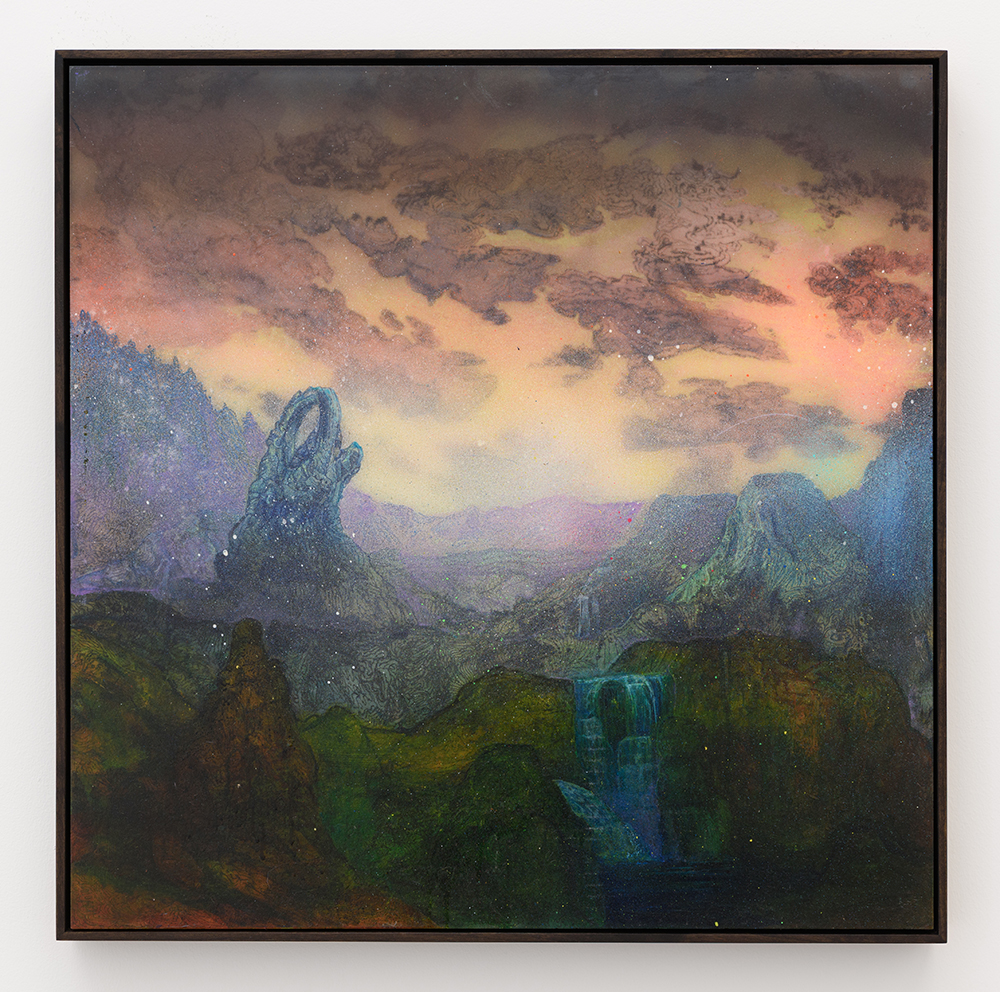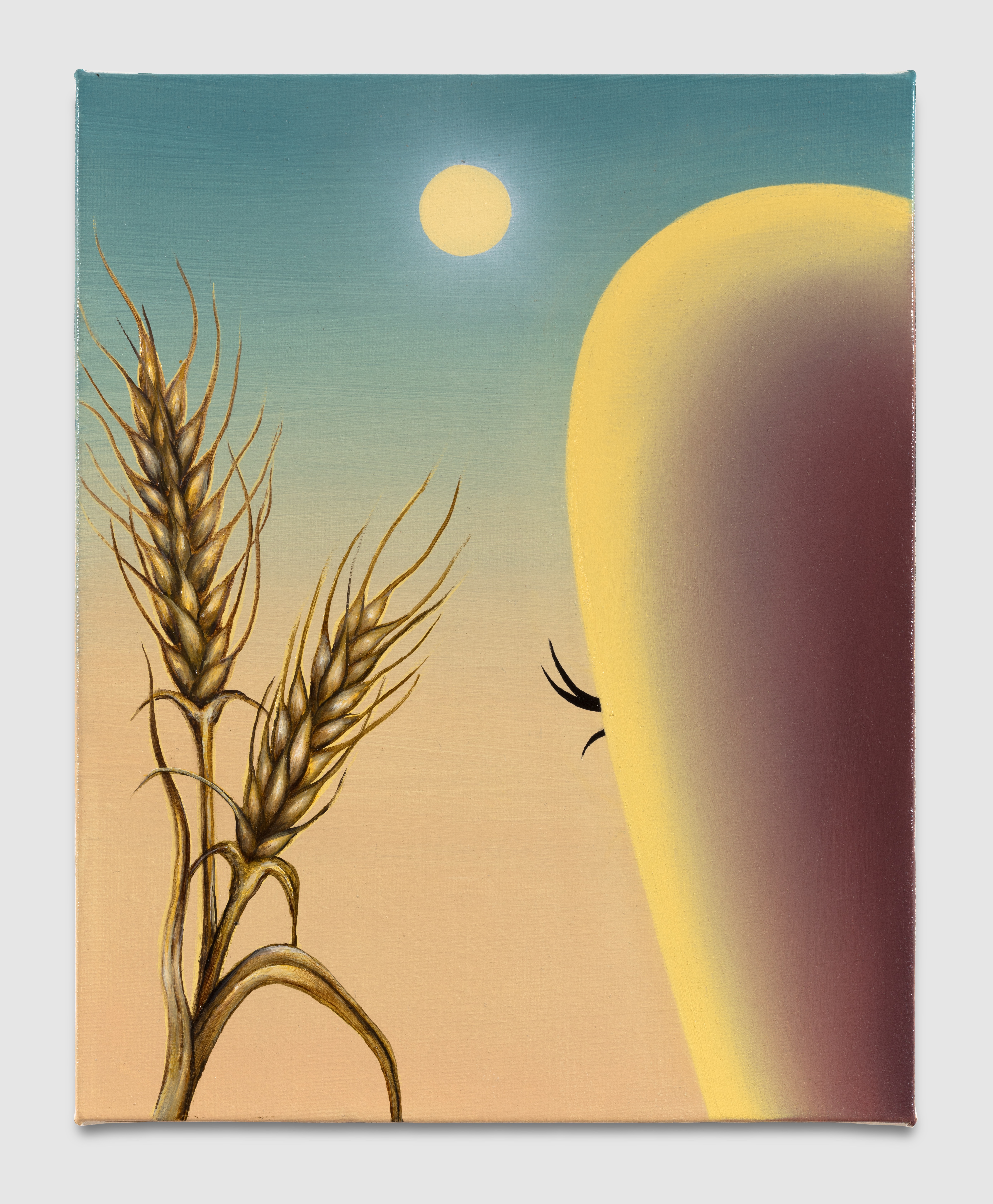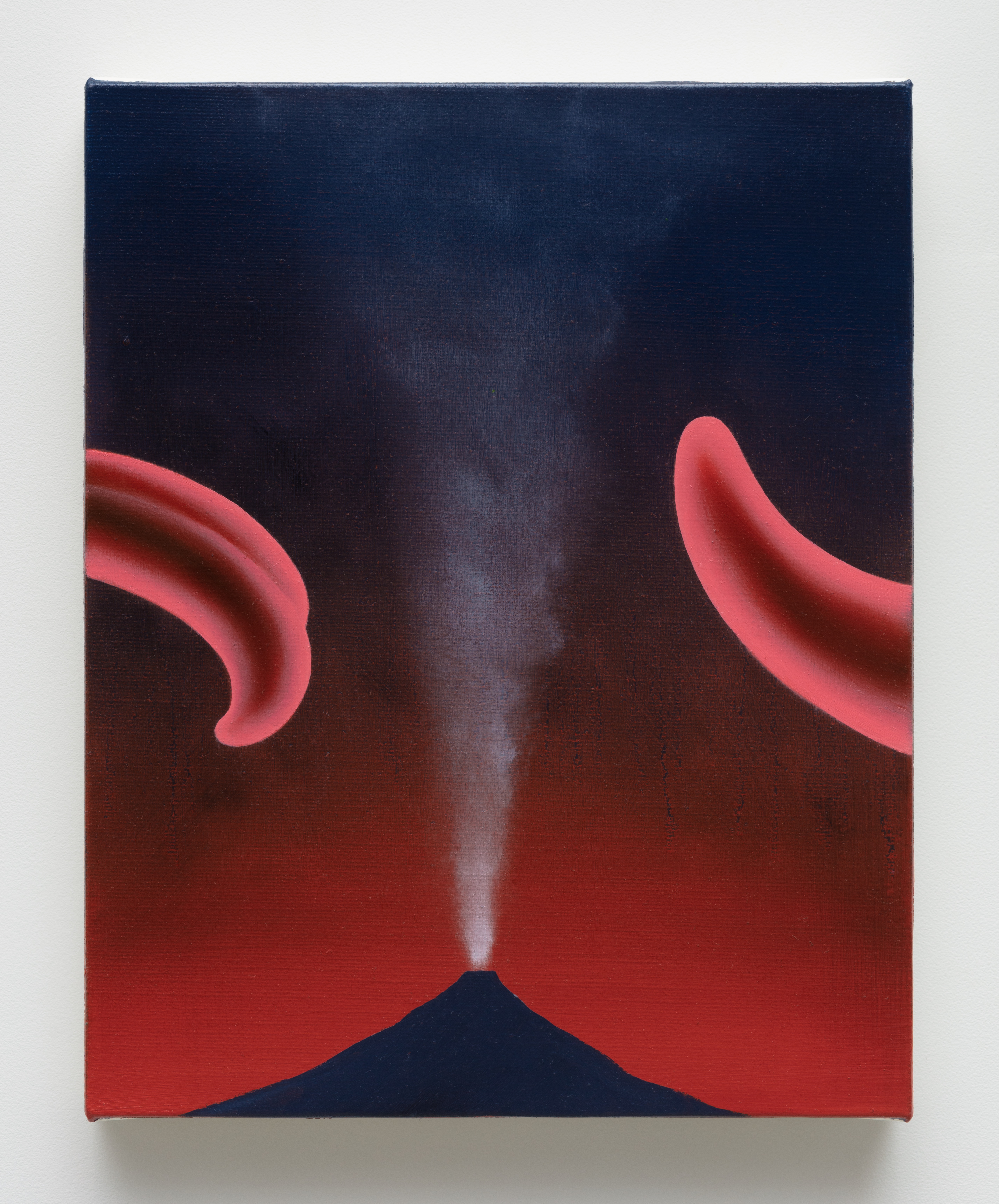In conversation: Joan Nelson and Emily Mae Smith
Emily Mae Smith: How do you prefer to be called as someone who does what you do—An artist? A painter? Another word? For some people it's a very political question, and for others it elicits nary a thought. It's one that I have dealt with. I am wondering where you fall on that topic.
Joan Nelson: I usually go with painter.
EMS: Some people write about your work having an historical relationship with German Romanticism, the 19th century, the Hudson River School, and the like. I'm from the American Southwest so I first thought of your work in the historical context of American Transcendental Painting, which was happening in the West and Southwest, as well as the East, and which was more of a 20th century phenomenon, and includes non-objective art. Who do you see as kin? I saw that you are from California so I wondered about that. Perhaps there are some surprising figures that you like which people had not thought to relate with your work.

Joan Nelson, Untitled, 2021
JN: Growing up in Manhattan Beach, CA in the 60s, we had family friends who had a big painting of a horse emerging through eucalyptus or willow branches in dappled sunlight. It was in the California Impressionist style. I think it was the first time I had a relationship with a painting. I loved it so much. I was about ten years old.
“Painting can be very amusing and joyful. Being forgetful opens up wonderful opportunities to glory in the moment of discovery.”
—Joan Nelson
Ernst Haeckel is important to me. I’ve done lots of copies of his work and I love the intricacies of Diatoms. The regularity of systems in the natural world helps me to clarify other order that occurs in nature like the sea or cloud forms, for example. By keeping in mind that there is a place for order, I can hopefully remember to fight my urge to order things that should be random. I wish to make the subject feel “natural” and that often means not neatly patterned/structured. Thinking about the concept of “natural” plays a big part in my work. Traditional depth perception techniques are something I have to consciously think about because they are still not second-nature to me. Conscious thought has to insert itself into the feeling-based sort of painting I do. Rocks and mountains have a specific form, but I struggle to remember what that is while in the act of working. Often I find myself asking, “wait, what do clouds/mountains/water/etc look like?” There are so many natural and geophysical tropes and they don’t come naturally to me. It’s just so funny. Painting can be very amusing and joyful. Being forgetful opens up wonderful opportunities to glory in the moment of discovery.

Joan Nelson, Untitled, 2019
EMS: How much does reference versus imagination figure into your work? Has that changed over time? I was recently in upstate New York and saw an incredible mist in the landscape while I was thinking about your work, but I thought it was more life imitating art. Your work somehow created a frame of reference for me to see that mist, otherwise I might not have noticed it.
“By keeping in mind that there is a place for order, I can hopefully remember to fight my urge to order things that should be random.”
—Joan Nelson
JN: I’m so happy I helped you in mist observation! Reference to something I’ve seen can get the ball rolling, but if I’m too true to the reference, I get frustrated. I’ll never be able to replicate the magic that happens when I feel that nearly nauseous feeling from experiencing extreme beauty. I force myself to put the reference away and jump over the cliff at some point, and rely only on my imagination for better or worse.
EMS: Your range of materials and techniques is so interesting. In the current presentation at Frieze there are paintings on wood, paper, and plexiglass. You use so many kinds of material and application techniques to paint. You even work in reverse on the back of a surface and present it from the front. It's extremely rare to see a painter using this variety and working in an objective or even semi-objective manner. This incredible amount of laying, both conceptual and technical, is one of the things that really excites me as a painter about your work. How did you arrive at these processes? I would love to hear about your journey in any depth you want to reveal.
![]()
Joan Nelson, Untitled, 2021
JN: I think the visual layering in a landscape—foreground, middle ground, far away, farther away, even farther away, infinitely far away—inspired the physical process of layering. The plexiglass offers a physical distance, which is tiny, but important. Perspectives from both behind and in front can be experienced. Other physical distancing materials are beeswax, which is semi transparent, glitter, matte mediums, spray paint—all obscure what is underneath. The journey has been making small discoveries over 42 years of painting I suppose?
EMS: Could you tell me about your practice? What is your schedule like? Do you have a dedicated studio space? Do you have all your materials out or tucked in drawers? Do you paint flat on a table, on the wall, or an easel?
![]()
Emily Mae Smith, Kin, 2020
JN: When I am in the zone I work from 8am to 6pm or so with a snack and occasional breaks. The low light of winter usually saps my energy a bit. Winters in upstate NY are from November to April, and there are very many cloudy days. During that time I work a few hours a day, and just sit or read for the rest. I have a studio in the house for most of the work I do, and another work space for spray painting (which I do outdoors if I can) and other messier parts of the process like pouring a layer on. I start with a neat, organized space and then in the heat of things I end up spread out all over the place. Work goes from table to wall, then back and forth. I have little plexi shelves to put work on so I can get far away to see how things are working from a distance.
“I think the visual layering in a landscape—foreground, middle ground, far away, farther away, even farther away, infinitely far away—inspired the physical process of layering.”
EMS: Could you tell me a story about an artistic triumph and an artistic despair? Human time is so short and hard to grasp in the grander scale of the universe, which seems to be another theme in your work. In the present context people can have a very short attention span and don't always pay respect to the lifetime investment and journey some artists make to their work. I believe I read that you were showing your work in New York's east village in the 1980s which peaked my curiosity for stories.
JN: You would hear way more stories than anyone would want to if you spent time with me. Curiously, I can’t come up with one on demand!
![]()
Emily Mae Smith, Sizzler, 2021
EMS: Is there anything you can impart to artists who are emerging at present?
JN: I would say to anyone who is an artist to keep making work. You are an artist if you make art. You don’t need to go to school, you don’t need to consistently show. Just make the damn art. Through working we grow. Ideally it is a compulsion and can’t be stopped.
Emily Mae Smith’s (b. 1979, Austin, TX; currently lives and works in Brooklyn, NY) sly, humorous, and riveting compositions nod to art historical movements such as Symbolism and Art Nouveau, though with a distinctly 21st century spin. Her genre-defying paintings speak through a vocabulary of signs and symbols addressing timely subjects including gender, class, and violence. Smith's paintings tackle art history's phallocentric myths and create imagery for subjectivities absent in visual culture, specifically the feminist perspective.
Recent solo exhibitions include: Simone Subal Gallery, New York, NY (2020, 2017); SCAD Museum of Art, Savannah, GA (2020); Marion Art Gallery, Rockefeller Arts Center, SUNY Fredonia, NY (2020); Galerie Perrotin, Tokyo (2019); Wadsworth Atheneum Museum of Art, Hartford, CT (2019); Le Consortium Museum, Dijon, France (2018); Contemporary Fine Arts, Berlin, Germany (2018); Galerie Perrotin (with Genesis Belanger), New York, NY (2018); SALTS (with Adam Henry), Basel, Switzerland (2017); Rodolphe Janssen, Brussels, Belgium (2016); Mary Mary, Glasgow, Scotland, UK (2016); and Laurel Gitlen, New York, NY (2015).
Select group exhibitions include: Cleveland Institute of Art, Cleveland, OH (2020); Public Art Fund, New York, NY (2020); Petzel Gallery, New York, NY (2020); Hauser & Wirth, New York, NY (2019); Arsenal art contemporain, Montreal, Canada (2019); Gio Marconi, Milan, Italy (2019); Peter Freeman Inc., New York, NY (2018); Tanya Bonakdar Gallery, New York, NY (2018); Lumber Room, Portland, OR (2017); König Galerie, Berlin, Germany (2016); The Moore Building, Miami, FL (2015); and Skirball Museum, Cincinnati, OH (2014).
Smith’s work is included in the collections of The Consortium Museum, Dijon, France; Columbus Museum of Art, Columbus, Ohio; Arsenal Contemporary, Montreal, Canada; Whitney Museum of American Art, New York, NY; Blanton Museum of Art, Austin, TX; Dallas Museum of Art, Dallas, TX, and Zuzeum Art Centre, Riga, Latvia.

Joan Nelson, Untitled, 2021
JN: I think the visual layering in a landscape—foreground, middle ground, far away, farther away, even farther away, infinitely far away—inspired the physical process of layering. The plexiglass offers a physical distance, which is tiny, but important. Perspectives from both behind and in front can be experienced. Other physical distancing materials are beeswax, which is semi transparent, glitter, matte mediums, spray paint—all obscure what is underneath. The journey has been making small discoveries over 42 years of painting I suppose?
EMS: Could you tell me about your practice? What is your schedule like? Do you have a dedicated studio space? Do you have all your materials out or tucked in drawers? Do you paint flat on a table, on the wall, or an easel?

Emily Mae Smith, Kin, 2020
JN: When I am in the zone I work from 8am to 6pm or so with a snack and occasional breaks. The low light of winter usually saps my energy a bit. Winters in upstate NY are from November to April, and there are very many cloudy days. During that time I work a few hours a day, and just sit or read for the rest. I have a studio in the house for most of the work I do, and another work space for spray painting (which I do outdoors if I can) and other messier parts of the process like pouring a layer on. I start with a neat, organized space and then in the heat of things I end up spread out all over the place. Work goes from table to wall, then back and forth. I have little plexi shelves to put work on so I can get far away to see how things are working from a distance.
“I think the visual layering in a landscape—foreground, middle ground, far away, farther away, even farther away, infinitely far away—inspired the physical process of layering.”
—Joan Nelson
EMS: Could you tell me a story about an artistic triumph and an artistic despair? Human time is so short and hard to grasp in the grander scale of the universe, which seems to be another theme in your work. In the present context people can have a very short attention span and don't always pay respect to the lifetime investment and journey some artists make to their work. I believe I read that you were showing your work in New York's east village in the 1980s which peaked my curiosity for stories.
JN: You would hear way more stories than anyone would want to if you spent time with me. Curiously, I can’t come up with one on demand!

Emily Mae Smith, Sizzler, 2021
EMS: Is there anything you can impart to artists who are emerging at present?
JN: I would say to anyone who is an artist to keep making work. You are an artist if you make art. You don’t need to go to school, you don’t need to consistently show. Just make the damn art. Through working we grow. Ideally it is a compulsion and can’t be stopped.
Emily Mae Smith’s (b. 1979, Austin, TX; currently lives and works in Brooklyn, NY) sly, humorous, and riveting compositions nod to art historical movements such as Symbolism and Art Nouveau, though with a distinctly 21st century spin. Her genre-defying paintings speak through a vocabulary of signs and symbols addressing timely subjects including gender, class, and violence. Smith's paintings tackle art history's phallocentric myths and create imagery for subjectivities absent in visual culture, specifically the feminist perspective.
Recent solo exhibitions include: Simone Subal Gallery, New York, NY (2020, 2017); SCAD Museum of Art, Savannah, GA (2020); Marion Art Gallery, Rockefeller Arts Center, SUNY Fredonia, NY (2020); Galerie Perrotin, Tokyo (2019); Wadsworth Atheneum Museum of Art, Hartford, CT (2019); Le Consortium Museum, Dijon, France (2018); Contemporary Fine Arts, Berlin, Germany (2018); Galerie Perrotin (with Genesis Belanger), New York, NY (2018); SALTS (with Adam Henry), Basel, Switzerland (2017); Rodolphe Janssen, Brussels, Belgium (2016); Mary Mary, Glasgow, Scotland, UK (2016); and Laurel Gitlen, New York, NY (2015).
Select group exhibitions include: Cleveland Institute of Art, Cleveland, OH (2020); Public Art Fund, New York, NY (2020); Petzel Gallery, New York, NY (2020); Hauser & Wirth, New York, NY (2019); Arsenal art contemporain, Montreal, Canada (2019); Gio Marconi, Milan, Italy (2019); Peter Freeman Inc., New York, NY (2018); Tanya Bonakdar Gallery, New York, NY (2018); Lumber Room, Portland, OR (2017); König Galerie, Berlin, Germany (2016); The Moore Building, Miami, FL (2015); and Skirball Museum, Cincinnati, OH (2014).
Smith’s work is included in the collections of The Consortium Museum, Dijon, France; Columbus Museum of Art, Columbus, Ohio; Arsenal Contemporary, Montreal, Canada; Whitney Museum of American Art, New York, NY; Blanton Museum of Art, Austin, TX; Dallas Museum of Art, Dallas, TX, and Zuzeum Art Centre, Riga, Latvia.